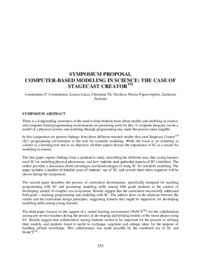| dc.contributor.author | Constantinou, Constantinos P. | en |
| dc.contributor.author | Louca, Loucas | en |
| dc.contributor.author | Nicolaou, Christiana Th. | en |
| dc.contributor.author | Papaevripidou, Marios | en |
| dc.contributor.author | Zacharia, Zacharias C. | en |
| dc.coverage.spatial | CY - Λευκωσία | en |
| dc.creator | Constantinou, Constantinos P. | en |
| dc.creator | Louca, Loucas | en |
| dc.creator | Nicolaou, Christiana Th. | en |
| dc.creator | Papaevripidou, Marios | en |
| dc.creator | Zacharia, Zacharias C. | en |
| dc.date.accessioned | 2016-02-12T10:12:08Z | |
| dc.date.available | 2016-02-12T10:12:08Z | |
| dc.date.issued | 2005 | |
| dc.identifier.uri | http://hdl.handle.net/10797/14650 | en |
| dc.description | Περιέχει τη περίληψη | el |
| dc.description.abstract | There is a longstanding awareness of the need to help students learn about models and modeling in science, and computer-based programming environments are promising tools for this. A computer program can be a model of a physical system, and modeling through programming may make the process more tangible. In this symposium we present findings from three different research studies that used Stagecast CreatorTM (SC) programming environment as the tool for scientific modeling. While the focus is on modeling in science as a learning tool and as an objective, all three papers discuss the importance of SC as a means for modeling in science. The first paper reports findings from a qualitative study, describing the different ways that young learners used SC for modeling physical phenomena, and how students used particular aspects of SC’s interface. The author provides a discussion about advantages and disadvantages of using SC for scientific modeling. The paper includes a number of detailed cases of students’ use of SC, and several short video segments will be shown during the symposium. The second paper describes the process of curriculum development, specifically designed for teaching programming with SC and promoting modeling skills among fifth grade students in the context of developing models of complex sea ecosystems. Results suggest that the curriculum successfully addressed both goals – teaching programming and modeling with SC. The authors draw on the relations between the results and the curriculum design principles, suggesting features that might be supportive for developing modeling skills among young learners.
The third paper focuses on the support of a virtual learning environment (WebCTTM) for the collaboration among pre-service teachers during the process of developing and refining models of the moon phases using SC. Results suggest that collaboration among students turned to be important for the process of refining their models, and students found it useful to exchange, negotiate and critique ideas for the purpose of building refined knowledge. This collaboration was made possible by the combined use of SC and WebCTTM. | en |
| dc.language.iso | eng | en |
| dc.publisher | University of Zilina | en |
| dc.relation.ispartof | Computer-based modeling in science: the case of stagecast creator | en |
| dc.rights | info:eu-repo/semantics/openAccess | en |
| dc.rights | Open Access | en |
| dc.source | CBLIS Conference Proceedings 2005 Integrating New Technologies in Science and Education | en |
| dc.title | Symposium proposal computer-based modeling in science: the case of stagecast creator | en |
| dc.title.alternative | Computer-based modeling in science: the case of stagecast creator | en |
| dc.type | info:eu-repo/semantics/conferenceObject | en |
| dc.contributor.conferenceorganizer | Learning in Science Group, University of Cyprus | en |
| dc.contributor.coordinator | Constantinou, Constantinos P. | en |
